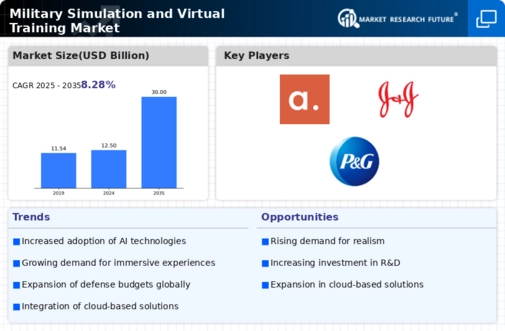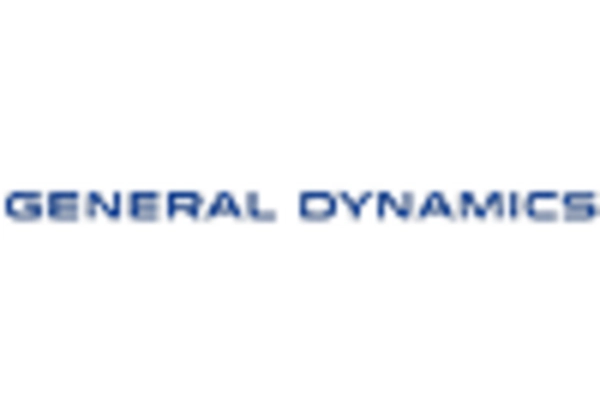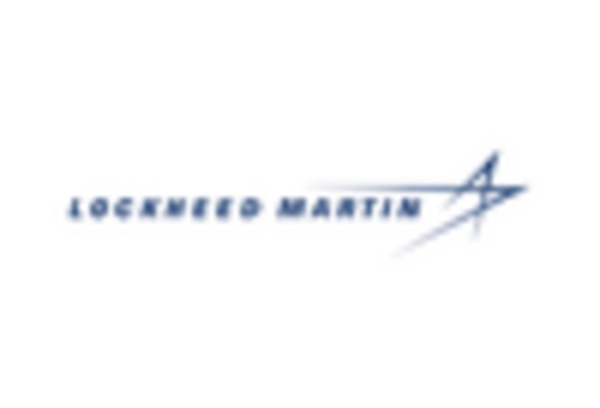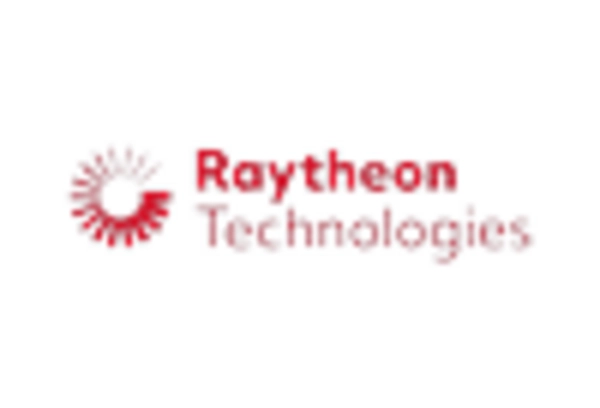-
Executive Summary
-
Market Attractiveness Analysis 21
- Global Military Simulation And Virtual Training Market, By Platform 21
- Global Military Simulation And Virtual Training Market, By Training Type 25
-
Market Introduction
-
Definition 26
-
Scope Of The Study 26
-
Market Structure 27
-
Key Buying Criteria 27
-
Research Methodology
-
Research Process 28
-
Primary Research 29
-
Secondary Research 30
-
Market Size Estimation 30
-
Forecast Model 31
-
List Of Assumptions 32
-
Market Insights
-
Market Dynamics
-
Introduction 36
-
Drivers 37
- Growing Emphasis On Maritime Security And Subsequent Focus On Virtual Solutions For Naval Training 37
- Focus On Implementing Flight Simulators For Training Combat Aircraft Pilots 38
- Drivers Impact Analysis 39
-
Restraint 39
- Replication Of Physiological Effects 39
- Restraints Impact Analysis 39
-
Opportunity 40
- Increasing Adoption Of AR Technology In Aerospace & Defense Sector 40
- Increased Use Of UAVs And Subsequent Focus On Drone Simulators 40
-
Trends 41
- Changing Nature Of Warfare And Focus On Developing Synthetic Training Environment 41
-
Market Factor Analysis
-
Porter’s Five Forces Model 42
- Threat Of New Entrants 42
- Bargaining Power Of Suppliers 42
- Bargaining Power Of Buyers 42
- Threat Of Substitutes 43
- Intensity Of Rivalry 43
-
Supply Chain 43
-
Technological Trends 44
- Full Combat & Mission Training In A Dome Trainer Environment 44
- BlueFire Technology 44
- Night Vision Training (NVT) Systems 44
- Real-Time Computer Image Generation 44
- Optimal Motion-Cueing Technology 44
- Reconfigurable Military Simulation And Virtual Training 45
-
Global Military Simulation And Virtual Training Market, By Platform
-
Overview 46
- Airborne 47
- Ground 49
- Naval 50
-
Global Military Simulation And Virtual Training Market, By Training Type
-
Overview 52
- Live 53
- Virtual Reality (VR) 53
- Constructive 53
- Gaming Simulation 53
-
Global Military Simulation And Virtual Training Market, By Region
-
Overview 54
-
North America 56
- US 60
- Canada 62
-
Europe 65
- France 69
- UK 71
- Germany 74
- Russia 76
- Rest Of Europe 79
-
Asia-Pacific 82
- China 86
- India 88
- Japan 91
- Rest Of Asia-Pacific 93
-
Latin America 96
- Brazil 99
- Rest Of Latin America 102
-
Middle East & Africa 105
- Israel 109
- UAE 112
- Saudi Arabia 114
- Rest Of The Middle East & Africa 117
-
Competitive Landscape
-
Competitive Overview 120
-
Competitor Dashboard 120
-
Capital Market Ratio And Financial Matrix 121
-
Major Growth Strategy In The Global Military Simulation & Virtual Training Market 122
-
Competitive Benchmarking 122
-
Market Share Analysis 123
-
Leading Player In Terms Of Number Of Developments In Global Military Simulation & Virtual Training Market 123
-
Key Developments & Growth Strategies 124
- Contracts And Agreements 124
- Mergers & Acquisitions 125
- Product Launches And Developments 125
- Expansions, Partnership, And Collaboration 125
-
Company Profiles
-
CAE Inc. 126
- Company Overview 126
- Financial Overview 126
- Products/Services Offered 127
- Key Developments 127
- SWOT Analysis 128
- Key Strategies 128
-
Cubic Corporation 129
- Company Overview 129
- Financial Overview 129
- Products/Services Offered 130
- Key Developments 130
- SWOT Analysis 131
- Key Strategies 131
-
L3Harris Technologies, Inc. 132
- Company Overview 132
- Financial Overview 132
- Products/Services Offered 132
- Key Developments 133
- SWOT Analysis 133
- Key Strategies 133
-
Lockheed Martin Corporation 134
- Company Overview 134
- Financial Overview 134
- Products/Services Offered 135
- Key Developments 135
- SWOT Analysis 136
- Key Strategies 136
-
Meggitt PLC 137
- Company Overview 137
- Financial Overview 137
- Products/Services/Solutions Offered 138
- Key Developments 138
- SWOT Analysis 139
- Key Strategies 139
-
Northrop Grumman Corporation 140
- Company Overview 140
- Financial Overview 140
- Products/Services Offered 141
- Key Developments 141
- SWOT Analysis 142
- Key Strategies 142
-
Rheinmetall AG 143
- Company Overview 143
- Financial Overview 143
- Products/Services/Solutions Offered 144
- Key Developments 144
- SWOT Analysis 145
- Key Strategies 145
-
United Technologies Corporation 146
- Company Overview 146
- Financial Overview 146
- Products/Services Offered 147
- Key Developments 147
- SWOT Analysis 148
- Key Strategies 148
-
Saab AB 149
- Company Overview 149
- Financial Overview 149
- Products/Services Offered 150
- Key Developments 150
- SWOT Analysis 150
- Key Strategies 151
-
Thales Group 152
- Company Overview 152
- Financial Overview 152
- Products/Services Offered 153
- Key Developments 153
- SWOT Analysis 154
- Key Strategies 154
-
Raytheon Company 155
- Company Overview 155
- Financial Overview 155
- Products/Services Offered 156
- Key Developments 156
- SWOT Analysis 157
- Key Strategies 157
-
Appendix
-
References 158
-
Related Reports 158
-
List Of Abbreviation 158
-
-
List Of Tables
-
LIST OF ASSUMPTIONS 32
-
GLOBAL MILITARY SIMULATION AND VIRTUAL TRAINING MARKET, BY PLATFORM, 2030-2030(USD MILLION) 46
-
MILITARY SIMULATION AND VIRTUAL TRAINING MARKET, BY AIRBORNE, 2030-2030(USD MILLION) 48
-
MILITARY SIMULATION AND VIRTUAL TRAINING MARKET, BY GROUND, 2030-2030(USD MILLION) 50
-
MILITARY SIMULATION AND VIRTUAL TRAINING MARKET, BY NAVAL, 2030-2030(USD MILLION) 51
-
GLOBAL MILITARY SIMULATION AND VIRTUAL TRAINING MARKET, BY TRAINING TYPE, 2030-2030(USD MILLION) 53
-
GLOBAL MILITARY SIMULATION AND VIRTUAL TRAINING MARKET, BY REGION, 2030-2030(USD MILLION) 55
-
NORTH AMERICA: MILITARY EXPENDITURE OF KEY COUNTRIES, 2017 VS 2030 (USD MILLION) 56
-
NORTH AMERICA: MILITARY SIMULATION AND VIRTUAL TRAINING MARKET, BY COUNTRY, 2030-2030(USD MILLION) 57
-
NORTH AMERICA: MILITARY SIMULATION AND VIRTUAL TRAINING MARKET, BY PLATFORM, 2030-2030(USD MILLION) 57
-
NORTH AMERICA: MILITARY SIMULATION AND VIRTUAL TRAINING MARKET, BY AIRBORNE, 2030-2030(USD MILLION) 58
-
NORTH AMERICA: MILITARY SIMULATION AND VIRTUAL TRAINING MARKET, BY GROUND, 2030-2030(USD MILLION) 58
-
NORTH AMERICA: MILITARY SIMULATION AND VIRTUAL TRAINING MARKET, BY NAVAL, 2030-2030(USD MILLION) 59
-
NORTH AMERICA: MILITARY SIMULATION AND VIRTUAL TRAINING MARKET, BY TRAINING TYPE, 2030-2030(USD MILLION) 59
-
US: MILITARY SIMULATION AND VIRTUAL TRAINING MARKET, BY PLATFORM, 2030-2030(USD MILLION) 60
-
US: MILITARY SIMULATION AND VIRTUAL TRAINING MARKET, BY AIRBORNE, 2030-2030(USD MILLION) 60
-
US: MILITARY SIMULATION AND VIRTUAL TRAINING MARKET, BY GROUND, 2030-2030(USD MILLION) 61
-
US: MILITARY SIMULATION AND VIRTUAL TRAINING MARKET, BY NAVAL, 2030-2030(USD MILLION) 61
-
US: MILITARY SIMULATION AND VIRTUAL TRAINING MARKET, BY TRAINING TYPE, 2030-2030(USD MILLION) 62
-
CANADA: MILITARY SIMULATION AND VIRTUAL TRAINING MARKET, BY PLATFORM, 2030-2030(USD MILLION) 62
-
CANADA: MILITARY SIMULATION AND VIRTUAL TRAINING MARKET, BY AIRBORNE, 2030-2030(USD MILLION) 63
-
CANADA: MILITARY SIMULATION AND VIRTUAL TRAINING MARKET, BY GROUND, 2030-2030(USD MILLION) 63
-
CANADA: MILITARY SIMULATION AND VIRTUAL TRAINING MARKET, BY NAVAL, 2030-2030(USD MILLION) 64
-
CANADA: MILITARY SIMULATION AND VIRTUAL TRAINING MARKET, BY TRAINING TYPE, 2030-2030(USD MILLION) 64
-
EUROPE: MILITARY EXPENDITURE OF KEY COUNTRIES, 2017 VS 2030 (USD MILLION) 65
-
EUROPE: MILITARY SIMULATION AND VIRTUAL TRAINING MARKET, BY COUNTRY, 2030-2030(USD MILLION) 66
-
EUROPE: MILITARY SIMULATION AND VIRTUAL TRAINING MARKET, BY PLATFORM, 2030-2030(USD MILLION) 66
-
EUROPE: MILITARY SIMULATION AND VIRTUAL TRAINING MARKET, BY AIRBORNE, 2030-2030(USD MILLION) 67
-
EUROPE: MILITARY SIMULATION AND VIRTUAL TRAINING MARKET, BY GROUND, 2030-2030(USD MILLION) 67
-
EUROPE: MILITARY SIMULATION AND VIRTUAL TRAINING MARKET, BY NAVAL, 2030-2030(USD MILLION) 68
-
EUROPE: MILITARY SIMULATION AND VIRTUAL TRAINING MARKET, BY TRAINING TYPE, 2030-2030(USD MILLION) 68
-
FRANCE: MILITARY SIMULATION AND VIRTUAL TRAINING MARKET, BY PLATFORM, 2030-2030(USD MILLION) 69
-
FRANCE: MILITARY SIMULATION AND VIRTUAL TRAINING MARKET, BY AIRBORNE, 2030-2030(USD MILLION) 69
-
FRANCE: MILITARY SIMULATION AND VIRTUAL TRAINING MARKET, BY GROUND, 2030-2030(USD MILLION) 70
-
FRANCE: MILITARY SIMULATION AND VIRTUAL TRAINING MARKET, BY NAVAL, 2030-2030(USD MILLION) 70
-
FRANCE: MILITARY SIMULATION AND VIRTUAL TRAINING MARKET, BY TRAINING TYPE, 2030-2030(USD MILLION) 71
-
UK: MILITARY SIMULATION AND VIRTUAL TRAINING MARKET, BY PLATFORM, 2030-2030(USD MILLION) 71
-
UK: MILITARY SIMULATION AND VIRTUAL TRAINING MARKET, BY AIRBORNE, 2030-2030(USD MILLION) 72
-
UK: MILITARY SIMULATION AND VIRTUAL TRAINING MARKET, BY GROUND, 2030-2030(USD MILLION) 72
-
UK: MILITARY SIMULATION AND VIRTUAL TRAINING MARKET, BY NAVAL, 2030-2030(USD MILLION) 73
-
UK: MILITARY SIMULATION AND VIRTUAL TRAINING MARKET, BY TRAINING TYPE, 2030-2030(USD MILLION) 73
-
GERMANY: MILITARY SIMULATION AND VIRTUAL TRAINING MARKET, BY PLATFORM, 2030-2030(USD MILLION) 74
-
GERMANY: MILITARY SIMULATION AND VIRTUAL TRAINING MARKET, BY AIRBORNE, 2030-2030(USD MILLION) 74
-
GERMANY: MILITARY SIMULATION AND VIRTUAL TRAINING MARKET, BY GROUND, 2030-2030(USD MILLION) 75
-
GERMANY: MILITARY SIMULATION AND VIRTUAL TRAINING MARKET, BY NAVAL, 2030-2030(USD MILLION) 75
-
GERMANY: MILITARY SIMULATION AND VIRTUAL TRAINING MARKET, BY TRAINING TYPE, 2030-2030(USD MILLION) 76
-
RUSSIA: MILITARY SIMULATION AND VIRTUAL TRAINING MARKET, BY PLATFORM, 2030-2030(USD MILLION) 76
-
RUSSIA: MILITARY SIMULATION AND VIRTUAL TRAINING MARKET, BY AIRBORNE, 2030-2030(USD MILLION) 77
-
RUSSIA: MILITARY SIMULATION AND VIRTUAL TRAINING MARKET, BY GROUND, 2030-2030(USD MILLION) 77
-
RUSSIA: MILITARY SIMULATION AND VIRTUAL TRAINING MARKET, BY NAVAL, 2030-2030(USD MILLION) 78
-
RUSSIA: MILITARY SIMULATION AND VIRTUAL TRAINING MARKET, BY TRAINING TYPE, 2030-2030(USD MILLION) 78
-
REST OF EUROPE: MILITARY SIMULATION AND VIRTUAL TRAINING MARKET, BY PLATFORM, 2030-2030(USD MILLION) 79
-
REST OF EUROPE: MILITARY SIMULATION AND VIRTUAL TRAINING MARKET, BY AIRBORNE, 2030-2030(USD MILLION) 79
-
REST OF EUROPE: MILITARY SIMULATION AND VIRTUAL TRAINING MARKET, BY GROUND, 2030-2030(USD MILLION) 80
-
REST OF EUROPE: MILITARY SIMULATION AND VIRTUAL TRAINING MARKET, BY NAVAL, 2030-2030(USD MILLION) 80
-
REST OF EUROPE: MILITARY SIMULATION AND VIRTUAL TRAINING MARKET, BY TRAINING TYPE, 2030-2030(USD MILLION) 81
-
ASIA-PACIFIC: MILITARY EXPENDITURE OF KEY COUNTRIES, 2017 VS 2030 (USD MILLION) 82
-
ASIA-PACIFIC: MILITARY SIMULATION AND VIRTUAL TRAINING MARKET, BY COUNTRY, 2030-2030(USD MILLION) 83
-
ASIA-PACIFIC: MILITARY SIMULATION AND VIRTUAL TRAINING MARKET, BY PLATFORM, 2030-2030(USD MILLION) 83
-
ASIA-PACIFIC: MILITARY SIMULATION AND VIRTUAL TRAINING MARKET, BY AIRBORNE, 2030-2030(USD MILLION) 84
-
ASIA-PACIFIC: MILITARY SIMULATION AND VIRTUAL TRAINING MARKET, BY GROUND, 2030-2030(USD MILLION) 84
-
ASIA-PACIFIC: MILITARY SIMULATION AND VIRTUAL TRAINING MARKET, BY NAVAL, 2030-2030(USD MILLION) 85
-
ASIA-PACIFIC: MILITARY SIMULATION AND VIRTUAL TRAINING MARKET, BY TRAINING TYPE, 2030-2030(USD MILLION) 85
-
CHINA: MILITARY SIMULATION AND VIRTUAL TRAINING MARKET, BY PLATFORM, 2030-2030(USD MILLION) 86
-
CHINA: MILITARY SIMULATION AND VIRTUAL TRAINING MARKET, BY AIRBORNE, 2030-2030(USD MILLION) 86
-
CHINA: MILITARY SIMULATION AND VIRTUAL TRAINING MARKET, BY GROUND, 2030-2030(USD MILLION) 87
-
CHINA: MILITARY SIMULATION AND VIRTUAL TRAINING MARKET, BY NAVAL, 2030-2030(USD MILLION) 87
-
CHINA: MILITARY SIMULATION AND VIRTUAL TRAINING MARKET, BY TRAINING TYPE, 2030-2030(USD MILLION) 88
-
INDIA: MILITARY SIMULATION AND VIRTUAL TRAINING MARKET, BY PLATFORM, 2030-2030(USD MILLION) 88
-
INDIA: MILITARY SIMULATION AND VIRTUAL TRAINING MARKET, BY AIRBORNE, 2030-2030(USD MILLION) 89
-
INDIA: MILITARY SIMULATION AND VIRTUAL TRAINING MARKET, BY GROUND, 2030-2030(USD MILLION) 89
-
INDIA: MILITARY SIMULATION AND VIRTUAL TRAINING MARKET, BY NAVAL, 2030-2030(USD MILLION) 90
-
INDIA: MILITARY SIMULATION AND VIRTUAL TRAINING MARKET, BY TRAINING TYPE, 2030-2030(USD MILLION) 90
-
JAPAN: MILITARY SIMULATION AND VIRTUAL TRAINING MARKET, BY PLATFORM, 2030-2030(USD MILLION) 91
-
JAPAN: MILITARY SIMULATION AND VIRTUAL TRAINING MARKET, BY AIRBORNE, 2030-2030(USD MILLION) 91
-
JAPAN: MILITARY SIMULATION AND VIRTUAL TRAINING MARKET, BY GROUND, 2030-2030(USD MILLION) 92
-
JAPAN: MILITARY SIMULATION AND VIRTUAL TRAINING MARKET, BY NAVAL, 2030-2030(USD MILLION) 92
-
JAPAN: MILITARY SIMULATION AND VIRTUAL TRAINING MARKET, BY TRAINING TYPE, 2030-2030(USD MILLION) 93
-
REST OF ASIA-PACIFIC: MILITARY SIMULATION AND VIRTUAL TRAINING MARKET, BY PLATFORM, 2030-2030(USD MILLION) 93
-
REST OF ASIA-PACIFIC: MILITARY SIMULATION AND VIRTUAL TRAINING MARKET, BY AIRBORNE, 2030-2030(USD MILLION) 94
-
REST OF ASIA-PACIFIC: MILITARY SIMULATION AND VIRTUAL TRAINING MARKET, BY GROUND, 2030-2030(USD MILLION) 94
-
REST OF ASIA-PACIFIC: MILITARY SIMULATION AND VIRTUAL TRAINING MARKET, BY NAVAL, 2030-2030(USD MILLION) 95
-
REST OF ASIA-PACIFIC: MILITARY SIMULATION AND VIRTUAL TRAINING MARKET, BY TRAINING TYPE, 2030-2030(USD MILLION) 95
-
LATIN AMERICA: MILITARY EXPENDITURE OF KEY COUNTRIES, 2017 VS 2030 (USD MILLION) 96
-
LATIN AMERICA: MILITARY SIMULATION AND VIRTUAL TRAINING MARKET, BY COUNTRY, 2030-2030(USD MILLION) 97
-
LATIN AMERICA: MILITARY SIMULATION AND VIRTUAL TRAINING MARKET, BY PLATFORM, 2030-2030(USD MILLION) 97
-
LATIN AMERICA: MILITARY SIMULATION AND VIRTUAL TRAINING MARKET, BY AIRBORNE, 2030-2030(USD MILLION) 97
-
LATIN AMERICA: MILITARY SIMULATION AND VIRTUAL TRAINING MARKET, BY GROUND, 2030-2030(USD MILLION) 98
-
LATIN AMERICA: MILITARY SIMULATION AND VIRTUAL TRAINING MARKET, BY NAVAL, 2030-2030(USD MILLION) 98
-
LATIN AMERICA: MILITARY SIMULATION AND VIRTUAL TRAINING MARKET, BY TRAINING TYPE, 2030-2030(USD MILLION) 99
-
BRAZIL: MILITARY SIMULATION AND VIRTUAL TRAINING MARKET, BY PLATFORM, 2030-2030(USD MILLION) 99
-
BRAZIL: MILITARY SIMULATION AND VIRTUAL TRAINING MARKET, BY AIRBORNE, 2030-2030(USD MILLION) 100
-
BRAZIL: MILITARY SIMULATION AND VIRTUAL TRAINING MARKET, BY GROUND, 2030-2030(USD MILLION) 100
-
BRAZIL: MILITARY SIMULATION AND VIRTUAL TRAINING MARKET, BY NAVAL, 2030-2030(USD MILLION) 101
-
BRAZIL: MILITARY SIMULATION AND VIRTUAL TRAINING MARKET, BY TRAINING TYPE, 2030-2030(USD MILLION) 101
-
REST OF LATIN AMERICA: MILITARY SIMULATION AND VIRTUAL TRAINING MARKET, BY PLATFORM, 2030-2030(USD MILLION) 102
-
REST OF LATIN AMERICA: MILITARY SIMULATION AND VIRTUAL TRAINING MARKET, BY AIRBORNE, 2030-2030(USD MILLION) 102
-
REST OF LATIN AMERICA: MILITARY SIMULATION AND VIRTUAL TRAINING MARKET, BY GROUND, 2030-2030(USD MILLION) 103
-
REST OF LATIN AMERICA: MILITARY SIMULATION AND VIRTUAL TRAINING MARKET, BY NAVAL, 2030-2030(USD MILLION) 103
-
REST OF LATIN AMERICA: MILITARY SIMULATION AND VIRTUAL TRAINING MARKET, BY TRAINING TYPE, 2030-2030(USD MILLION) 104
-
MIDDLE EAST & AFRICA: MILITARY EXPENDITURE OF KEY COUNTRIES, 2017 VS 2030 (USD MILLION) 105
-
MIDDLE EAST & AFRICA: MILITARY SIMULATION AND VIRTUAL TRAINING MARKET, BY COUNTRY, 2030-2030(USD MILLION) 106
-
MIDDLE EAST & AFRICA: MILITARY SIMULATION AND VIRTUAL TRAINING MARKET, BY PLATFORM, 2030-2030(USD MILLION) 107
-
MIDDLE EAST & AFRICA: MILITARY SIMULATION AND VIRTUAL TRAINING MARKET, BY AIRBORNE, 2030-2030(USD MILLION) 107
-
MIDDLE EAST & AFRICA: MILITARY SIMULATION AND VIRTUAL TRAINING MARKET, BY GROUND, 2030-2030(USD MILLION) 108
-
MIDDLE EAST & AFRICA: MILITARY SIMULATION AND VIRTUAL TRAINING MARKET, BY NAVAL, 2030-2030(USD MILLION) 108
-
MIDDLE EAST & AFRICA: MILITARY SIMULATION AND VIRTUAL TRAINING MARKET, BY TRAINING TYPE, 2030-2030(USD MILLION) 109
-
ISRAEL: MILITARY SIMULATION AND VIRTUAL TRAINING MARKET, BY PLATFORM, 2030-2030(USD MILLION) 109
-
ISRAEL: MILITARY SIMULATION AND VIRTUAL TRAINING MARKET, BY AIRBORNE, 2030-2030(USD MILLION) 110
-
ISRAEL: MILITARY SIMULATION AND VIRTUAL TRAINING MARKET, BY GROUND, 2030-2030(USD MILLION) 110
-
ISRAEL: MILITARY SIMULATION AND VIRTUAL TRAINING MARKET, BY NAVAL, 2030-2030(USD MILLION) 111
-
ISRAEL: MILITARY SIMULATION AND VIRTUAL TRAINING MARKET, BY TRAINING TYPE, 2030-2030(USD MILLION) 111
-
UAE: MILITARY SIMULATION AND VIRTUAL TRAINING MARKET, BY PLATFORM, 2030-2030(USD MILLION) 112
-
UAE: MILITARY SIMULATION AND VIRTUAL TRAINING MARKET, BY AIRBORNE, 2030-2030(USD MILLION) 112
-
UAE: MILITARY SIMULATION AND VIRTUAL TRAINING MARKET, BY GROUND, 2030-2030(USD MILLION) 113
-
UAE: MILITARY SIMULATION AND VIRTUAL TRAINING MARKET, BY NAVAL, 2030-2030(USD MILLION) 113
-
UAE: MILITARY SIMULATION AND VIRTUAL TRAINING MARKET, BY TRAINING TYPE, 2030-2030(USD MILLION) 114
-
SAUDI ARABIA: MILITARY SIMULATION AND VIRTUAL TRAINING MARKET, BY PLATFORM, 2030-2030(USD MILLION) 114
-
SAUDI ARABIA: MILITARY SIMULATION AND VIRTUAL TRAINING MARKET, BY AIRBORNE, 2030-2030(USD MILLION) 115
-
SAUDI ARABIA: MILITARY SIMULATION AND VIRTUAL TRAINING MARKET, BY GROUND, 2030-2030(USD MILLION) 115
-
SAUDI ARABIA: MILITARY SIMULATION AND VIRTUAL TRAINING MARKET, BY NAVAL, 2030-2030(USD MILLION) 116
-
SAUDI ARABIA: MILITARY SIMULATION AND VIRTUAL TRAINING MARKET, BY TRAINING TYPE, 2030-2030(USD MILLION) 116
-
REST OF THE MIDDLE EAST & AFRICA: MILITARY SIMULATION AND VIRTUAL TRAINING MARKET, BY PLATFORM, 2030-2030(USD MILLION) 117
-
REST OF THE MIDDLE EAST & AFRICA: MILITARY SIMULATION AND VIRTUAL TRAINING MARKET, BY AIRBORNE, 2030-2030(USD MILLION) 117
-
REST OF THE MIDDLE EAST & AFRICA: MILITARY SIMULATION AND VIRTUAL TRAINING MARKET, BY GROUND, 2030-2030(USD MILLION) 118
-
REST OF THE MIDDLE EAST & AFRICA: MILITARY SIMULATION AND VIRTUAL TRAINING MARKET, BY NAVAL, 2030-2030(USD MILLION) 118
-
REST OF THE MIDDLE EAST & AFRICA: MILITARY SIMULATION AND VIRTUAL TRAINING MARKET, BY TRAINING TYPE, 2030-2030(USD MILLION) 119
-
THE MOST ACTIVE PLAYERS IN THE GLOBAL MILITARY SIMULATION & VIRTUAL TRAINING MARKET 123
-
CONTRACTS AND AGREEMENTS 124
-
MERGERS & ACQUISITIONS 125
-
PRODUCT LAUNCHES AND DEVELOPMENTS 125
-
EXPANSIONS, PARTNERSHIP, AND COLLABORATION 125
-
CAE INC.: PRODUCTS/SERVICES OFFERED 127
-
CAE INC.: KEY DEVELOPMENTS 127
-
CUBIC CORPORATION: PRODUCTS/SERVICES OFFERED 130
-
CUBIC CORPORATION: KEY DEVELOPMENTS 130
-
L3HARRIS TECHNOLOGIES, INC.: PRODUCTS/SERVICES OFFERED 132
-
L3HARRIS TECHNOLOGIES, INC.: KEY DEVELOPMENTS 133
-
LOCKHEED MARTIN CORPORATION: PRODUCTS/SERVICES OFFERED 135
-
LOCKHEED MARTIN CORPORATION: KEY DEVELOPMENTS 135
-
MEGGITT PLC: PRODUCTS/SERVICES/SOLUTIONS OFFERED 138
-
MEGGITT PLC: KEY DEVELOPMENTS 138
-
NORTHROP GRUMMAN CORPORATION: PRODUCTS/SERVICES OFFERED 141
-
NORTHROP GRUMMAN CORPORATION: KEY DEVELOPMENTS 141
-
RHEINMETALL AG: PRODUCTS/SERVICES/SOLUTIONS OFFERED 144
-
RHEINMETALL AG: KEY DEVELOPMENTS 144
-
UNITED TECHNOLOGIES CORPORATION: PRODUCTS/SERVICES OFFERED 147
-
UNITED TECHNOLOGIES CORPORATION: KEY DEVELOPMENTS 147
-
SAAB AB: PRODUCTS/SERVICES OFFERED 150
-
SAAB AB: KEY DEVELOPMENTS 150
-
THALES GROUP: PRODUCTS/SERVICES OFFERED 153
-
THALES GROUP: KEY DEVELOPMENTS 153
-
RAYTHEON COMPANY: PRODUCTS/SERVICES OFFERED 156
-
RAYTHEON COMPANY: KEY DEVELOPMENTS 156
-
-
List Of Figures
-
MARKET SYNOPSIS 20
-
GLOBAL MILITARY SIMULATION AND VIRTUAL TRAINING MARKET: MARKET ATTRACTIVENESS ANALYSIS 21
-
GLOBAL MILITARY SIMULATION AND VIRTUAL TRAINING MARKET ANALYSIS, BY PLATFORM 21
-
GLOBAL MILITARY SIMULATION AND VIRTUAL TRAINING MARKET ANALYSIS, BY AIRBORNE 22
-
GLOBAL MILITARY SIMULATION AND VIRTUAL TRAINING MARKET ANALYSIS, BY GROUND 23
-
GLOBAL MILITARY SIMULATION AND VIRTUAL TRAINING MARKET ANALYSIS, BY NAVAL 24
-
GLOBAL MILITARY SIMULATION AND VIRTUAL TRAINING MARKET ANALYSIS, BY TRAINING TYPE 25
-
GLOBAL MILITARY SIMULATION AND VIRTUAL TRAINING MARKET: MARKET STRUCTURE 27
-
KEY BUYING CRITERIA OF GLOBAL MILITARY SIMULATION AND VIRTUAL TRAINING MARKET 27
-
RESEARCH PROCESS OF MRFR 28
-
TOP-DOWN AND BOTTOM-UP APPROACHES 31
-
NORTH AMERICA: MARKET SIZE (USD MILLION) AND MARKET SHARE (%), BY COUNTRY, 2030 VS 2025 33
-
EUROPE: MARKET SIZE (USD MILLION) AND MARKET SHARE (%), BY COUNTRY, 2030 VS 2025 33
-
ASIA-PACIFIC: MARKET SIZE (USD MILLION) AND MARKET SHARE (%), BY COUNTRY, 2030 VS 2025 34
-
MIDDLE EAST & AFRICA: MARKET SIZE (USD MILLION) AND MARKET SHARE (%), BY COUNTRY, 2030 VS 2025 34
-
LATIN AMERICA: MARKET SIZE (USD MILLION) AND MARKET SHARE (%), BY COUNTRY (2030 VS 2025) 35
-
MARKET DYNAMICS OVERVIEW 36
-
CHANGE IN MILITARY SPENDING AMONG TOP 10 COUNTRIES (2007 – 2017) 38
-
DRIVERS IMPACT ANALYSIS: GLOBAL MILITARY SIMULATION AND VIRTUAL TRAINING MARKET 39
-
RESTRAINTS IMPACT ANALYSIS: GLOBAL MILITARY SIMULATION AND VIRTUAL TRAINING MARKET 39
-
PORTER'S FIVE FORCES ANALYSIS OF THE GLOBAL MILITARY SIMULATION AND VIRTUAL TRAINING MARKET 42
-
SUPPLY CHAIN:

















Leave a Comment